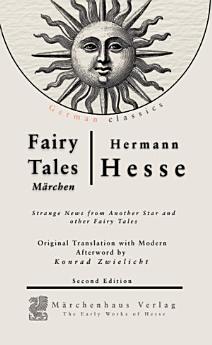Fairy Tales
The Early Works of Hermann Hesse Book 11 · Marchen Press
Ebook
240
Pages
family_home
Eligible
info
reportRatings and reviews aren’t verified Learn More
About this ebook
Published in Berlin amid the Spartacist riots and political assassinations, this collection reworks traditional folklore to grapple with postwar trauma. Stories like “Augustus” and “The Poet” employ allegory to critique societal fragmentation, their magical realism offering oblique commentary on a world unmoored by war. The tales’ publication coincided with Germany’s fraught transition to democracy, their themes of fractured identity and elusive redemption mirroring national introspection. In 1919, the same year Demian was published, Hermann Hesse also released Märchen, a collection of surreal and allegorical short stories often referred to in English as Fairy Tales or sometimes Strange News from Another Star (the latter being the title of one of the tales). These stories were actually written over the span of the 1910s—between 1913 and 1918, during the World War I period—and Hesse compiled them into a single volume as the war came to an end. Published by S. Fischer in Berlin, Märchen showcases a very different side of Hesse compared to the psychological realism of Demian. Here, Hesse indulges in dreamlike narratives, fables that take place in fantastical realms or abstract spaces of the soul. The 1919 collection included a number of now-famous Hesse short works, such as “The Painter” (Der Maler), “Flute Dream” (Flötentraum), “The Fairy Tale” (Märchen, the eponymous story), “Faldum”, “Iris”, and “Strange News from Another Star” (Merkwürdige Nachricht von einem anderen Stern), among others. English readers were introduced to many of these when the collection Strange News from Another Star and Other Tales was published, containing translations of the Märchen stories. The reception of these tales was interesting: having Demian and Märchen appear around the same time demonstrated Hesse’s range. Those hungry for symbolism and myth found rich material in Märchen, whereas those drawn to the more direct youth narrative had Demian. Over the years, Hesse’s Fairy Tales have become classics in their own right, appreciated for their poetic imagery and philosophical depth beneath the veneer of fantasy. Hesse’s decision to revisit fairy tales—a genre associated with cultural cohesion—during this period underscores his attempt to reclaim narrative stability. The collection’s juxtaposition of mythic archetypes with modernist ambiguity reflects broader Weimar-era tensions between tradition and avant-garde experimentation. Historically, it bridges prewar romanticism and the Neue Sachlichkeit’s disillusioned realism, capturing a society oscillating between nostalgia and reinvention. This new edition features a fresh, contemporary translation of Hesse's Fairy Tales into modern language. Enhanced by an illuminating Afterword focused on Hesse's personal and intellectual relationship with Carl Jung, a concise biography, a glossary of essential philosophical terms integral to his writings (his version of Jungian Psychological concepts) and a detailed chronology of his life and major works, this robust edition introduces the reader to the brilliance of his literature in context. It not only captures the depth and nuance of Hesse’s thought but also highlights its enduring impact on the debates of the mid-20th century, contemporary culture and Western Philosophy across the 20th and into the 21st century.
About the author
Herman Hesse (1877-1962) navigated a life shaped by psychological turbulence that fundamentally transformed his literary vision following his pivotal encounter with Carl Jung's analytical psychology. After suffering a severe breakdown in 1916 amid his crumbling first marriage and the ravages of World War I, Hesse underwent intensive psychoanalysis with Jung's student J.B. Lang and later with Jung himself, sessions that would profoundly alter his creative trajectory. This Jungian influence became evident in his subsequent works, particularly "Demian" and "Steppenwolf," where the protagonist's journey toward individuation—Jung's concept of integrating the conscious and unconscious aspects of personality—emerges as a central theme. Hesse's correspondence with Jung continued for decades, their intellectual relationship deepening as Hesse increasingly incorporated Jungian archetypes, dream symbolism, and the notion of the shadow self into his narratives of spiritual seeking. The writer later acknowledged that Jung's therapeutic methods had not only rescued him from psychological collapse but had fundamentally reshaped his understanding of human consciousness, enabling him to transmute his personal suffering into the allegorical quests for wholeness that characterized his most enduring works.RetryClaude can make mistakes. Please double-check responses.
Rate this ebook
Tell us what you think.
Reading information
Smartphones and tablets
Install the Google Play Books app for Android and iPad/iPhone. It syncs automatically with your account and allows you to read online or offline wherever you are.
Laptops and computers
You can listen to audiobooks purchased on Google Play using your computer's web browser.
eReaders and other devices
To read on e-ink devices like Kobo eReaders, you'll need to download a file and transfer it to your device. Follow the detailed Help Center instructions to transfer the files to supported eReaders.










